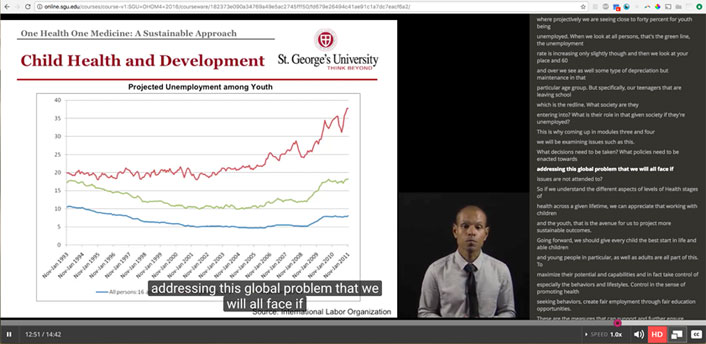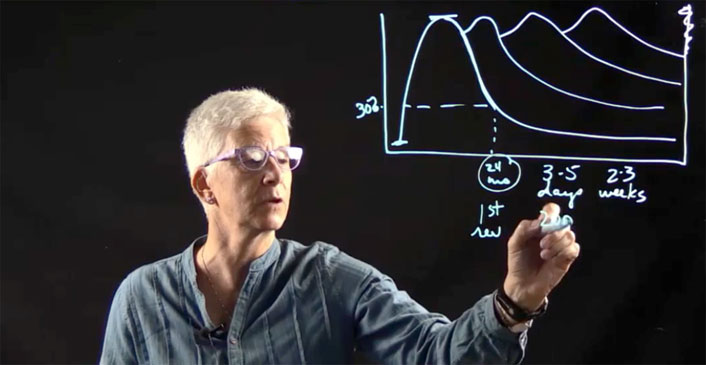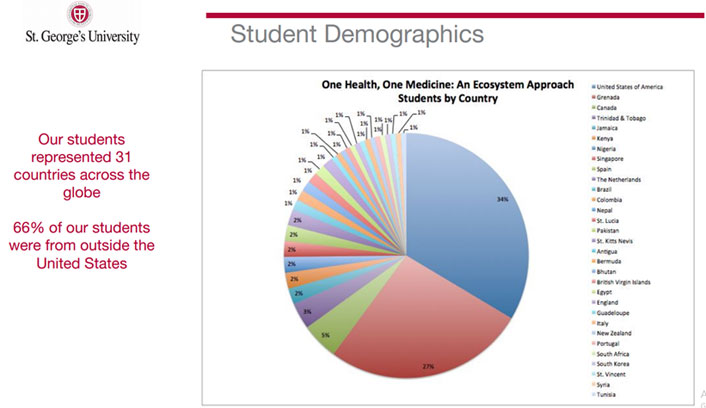Key Takeaways
- After mixed reviews on massive open online courses designed to attract students in developing countries fell short of expectations, the team at St. George's University in Grenada applied their academic and technological competencies to create a successful MOOC experience.
- Building the course from the platform up, carefully targeting the content, and offering real-time interactions and solid student support were key to the success.
- The experience proved successful in other ways as well, creating a powerful and, given the course's size, perhaps surprising connection among the students, instructor, and course team members.
Nothing in the name massive open online course (or "MOOC") denotes intimacy, connection, or community — particularly when the target student population is spread throughout the world. But in my experience, achieving all of those qualities is not only possible, but is, in fact, the point. Learning happens most easily when students feel connected to the content, the instructor, and each other. The key, then, is not simply to slap a course online and set up registration and a forum or two, but rather to carefully construct a course from the platform up with those goals and your prospective students in mind. The reward for doing so? A course experience that is as rewarding for instructors as for the students they teach.
At St. George's University in Grenada, West Indies, Chancellor Charles Modica had a vision of providing SGU education opportunities to students from around the world who face barriers to attending onsite campuses. At SGU having internationally recognized programs in medicine, veterinary medicine and public health as well as a global community of faculty, students and alumni, the approach was to deliver a course on integrating the various aspects of health and medicine into One Health One Medicine with a global perspective.
Course 1: A Standard Approach … Falls Short
Although we didn't realize it going in, our first course would prove to be crucial to our success, even as it met three times the average completion rates for MOOCs, which was still less than our goals and expectations.
Key Course Development Choices
We launched our first course, "One Health One Medicine," in 2013. When deciding on the topic, we chose the linkages between Human and Veterinary Medicine because it represented the strength of education offered at SGU as well as the nature of global health burdens from emerging infectious diseases.
We prepared the course based on our own curriculum and education standards from an academic context. We capped enrollment at 1,000 and had a full course, primarily of students from North America and Europe, with limited participation from developing countries. This first course served as both an introduction to the One Health One Medicine concept for the students and my own entry and introduction to developing and delivering MOOCs.
For the course development, we used an existing platform, which had specific requirements and resulted in a highly structured course.
Results
Our course had an 11 percent completion rate — almost double that of the average MOOC. However, we considered the rate low and the course to be somewhat of a failure. Further, the constraints of the predesigned platform meant that the course and its delivery were within the limits of the tools provided. Finally, the marketing and recruitment for the course was also restricted to the existing platform selected.
The course did succeed, however, in helping us realize what we needed to do moving forward:
- Build our own platform to escape the confines of traditional assumptions about online education
- Change our content focus to global health issues, to ensure its direct relevance to our target audience in developing countries
- Create a course built on interaction and engagement, providing our students with as close a replica as possible to the on-site classroom experience
Course 2: Applying Our Lessons Learned
In 2014 we launched our second course, One Health One Medicine: A Global Health Approach, on SGUx, a platform we built as a customized version of the Open EdX platform to increase opportunities to interact with students in real time. To recruit students, we partnered with international organizations and professional associations as well as social media groups and forums.
Course Development Choices
The choice to focus on infectious diseases was critical: from Ebola to influenza to West Nile and Chikungunya and Zika, infectious diseases are a concern of health professionals throughout the world, and especially in the developing world, where the diseases appear and prevention and control strategies are critical.
In developing the new platform, we focused on creating more opportunities for interaction. SGUx has built-in mechanisms for live interaction and lets us offer students both synchronous and asynchronous modalities. Asynchronous materials (typically recorded content and reading) are complemented with synchronous content, such as live seminars (see figures 1 and 2). To accommodate our global audience, we repeated each seminar three times a week at different days and times to suit students' various time zones. We also held office hours for different time zones, which further increased both the accessibility and interaction so critical in a developing country context.

Figure 1. Video with asynchronous content used in the course; the video also provides audio and text for students to use at their convenience.

Figure 2. Explaining a concept through a video lecture.
To ensure sufficient logistic and technical support, we created an online MOOC team, which includes a program director, an instructional designer, and a technical support personnel. Although I am "the content guy," I am but one member of a team that identifies and meets student needs. This is particularly important for students in developing countries, who have a greater dependency for technical support as a result of their limited experience in online education. Figure 3 shows a screen capture of a quiz question in Module 2 of the course.

Figure 3. An interactive quiz.
Results
Our second course attracted students from more than 45 countries, including 34 developing countries. In all, we had 850 students. In this case, our completion rate was over 22 percent.
The choice of content for the course proved invaluable: it was both specific and relevant, and everyone benefitted from the first-hand experiences of students from different parts of the world. Each week, I used infectious disease case studies that reflected issues and disease burdens affecting different populations and geographic locations. This also helped with recruitment, as people perusing the course description were likely to find at least one module that they could directly identify with in terms of their professional development and training, as well as their own health and well-being.
With course two, we both attracted a greater number of students from developing countries (figure 4) and had a better retention and completion rate (figure 5). We used our new approach to content and our platform-facilitated increase in live student engagement in a third course, One Health One Medicine: An Ecosystem Health Approach. In this MOOC, we once again achieved a 22 percent retention and completion rate and also increased the number of countries — especially 40 percent more developing countries — participating.

Figure 4. Students by country.

Figure 5. Student pass rates by country.
Advice for Creating MOOCs and Building Community
Our first MOOC attempt basically ported a regular course with standard times and content and attracted students from the standard student populations in the Western Hemisphere. As we learned, when you're looking at a nontraditional student context — in our case, the global, developing country context — you must use a different approach. Based on our experiences, I offer the following advice.
Build from Scratch
My first piece of advice is a don't — don't simply take one of your regular courses and try to replicate it in a MOOC setting. MOOC audiences are large and, in all contexts, they have particular needs, such as those relating to timing and technical support. When you add to that the context of a developing country, the need for support, interaction, and engagement grows, and you must build your course to accommodate those needs.
Maximize Interactions
In dealing with students from developing countries, interaction is essential. In my experience, live sessions are very important to building a learning community. These students also typically need more academic and technical support because the MOOC mixed methods of synchronous and asynchronous approaches engaged students from diverse educational and technological, not to mention geographical and time zone, perspectives. Beyond these basics, I found that the ability to visually connect with students and actually see all of their faces and engage in real-time and interactive discussions was very important. Our initial solution for this was to use a standard video/audio conferencing facility, but that did not allow for a full visual representation among those participating in any given session We now use an advanced conferencing facility, which rotates through students' faces throughout the class, so even if 50 or 60 people are in a meeting, I can see them all. This offered an increased connection with individual students, which was an important factor in our retention and completion rates.
Another key feature of our SGUx platform is that it allows for peer review, which builds ownership and responsibility into the course. Once students realize that they're in a peer-review class, the quality of their work becomes even more significant as their colleagues will see it along with the instructor. See figure 6.

Figure 6. Grade chart for the course.
We also make it possible for students to do both live and recorded presentations to the class. Our platform, which lets students prepare their own seminars as live and recorded content, enabled students to demonstrate their competencies in the course and for everyone to learn and participate in the course experience. Our online team members also participated in dedicated sessions to give students technical support in understanding the online educational experience and to maximize the potential of the online tools to their fullest potential. See figure 7.

Figure 7. A course discussion session.
As our students tell us, the interaction component of the course is key to keeping them engaged:
"The material was presented in a way which kept my attention. I was given the choice of pace. I enjoyed almost every aspect. I felt placed on the spot when I attended a virtual office session — never went back. I must say that having taken the course simply for the experience had been uplifting, rewarding and the experience had done wonders for my personal motivation. You cannot imagine. Thank you all for your assistance."
"For me, the course was more than passing exams and getting good scores but the knowledge gained is priceless and definitely has further motivated me to consider further studies in the area of Public Health. Thank you to all who made this course possible."
"I would like to thank the team for the wonderful presentations. I learned so much from this course, especially the videos."
Create a Strong Team
It was clear early on that creating an effective MOOC requires a team. In our first course, the team was simply myself and our program director, and we did our best. However, our experience highlighted the importance of a diverse team of professionals to meet each course's various demands. For the second course we built that team, which consists of the following people:
- Program director: Jonathan Modica directs online programs at SGU. His approach as we were developing this course was to simply ask me what I needed to effectively teach it. I would give him requirements — such as, "to see all my students in real time" — and he would come back with a wide variety of tools and applications for me to try.
- Instructional designer: John Swope built the SGUx platform and began working with me from the earliest iteration of the course development. Together, we designed and developed the courses, and he shared with me every process along the path so we could test them together. For example, we initially had eight modules, which we figured out was too time-consuming for students in a free, open course. So together, Swope and I contracted the class to four modules, ensuring that we kept the essential content while also being realistic about student needs and our own expectations for professional development while engaging in a rigorous course experience.
- Technical Support: Donna Walker, our onsite person, offers audio/visual, editing, and troubleshooting support for our courses. We have a studio on campus equipped with advanced smart devices, Learning Glass, professional lighting, and recording to ensure high course product quality; as a result of this infrastructure and Walker's efforts, the technical quality of our MOOC is very high.
- Course Instructor: my role on the team is to build course content in collaboration with the course team and facilitate the interactions with the students on the course content.
After our second MOOC, we added an additional contributor beyond our core team, partnering with the US National Board of Public Health Examiners (NBPHE) to offer continuing education credits to our students. They can now take a comprehensive exam at the end of the course; if they pass it, they are awarded credits by the NBPHE. So, not only is our course a free and intellectually enriching experience, it now also contributes to our students' professional development in a tangible, recognized way.
Conclusions
Creating any MOOC is a tremendous amount of work. You basically must construct and almost complete the course before it begins, doing all the preliminary work to get recordings, prepare content, and so on. When your audience is nontraditional students, that workload increases to include catering for a wide array of student interests as well as different academic backgrounds and competencies. However, the benefits of all that groundwork are clear when you're having experiences with students from all around the world, all sharing in a learning community on global topics. In any given session, I might have 50 students from 50 different countries participating, which is as enriching an experience as an onsite one where I would have learned a lot from the experiences of others. Hopefully they learn as much from me as I certainly learn from them.
MOOCs are not just an arbitrary online course to put out there to maximize numbers and see how many people hang in to complete the course. At least they don't need to be. You will get the completion, you will get a success, but MOOCs are really about building a learning community together — with your students, with your course team, and with the faculty. Once you have a community and people take ownership of it, it becomes a living community. The last week of class is always a sad one in our courses because we all enjoy each other's experiences, company, and exchanges. That community effect is powerful — and it is possible in all MOOCs. I encourage you to design and deliver MOOCs with that goal in mind.
Satesh Bidaisee is an associate professor of Public Health and Preventive Medicine and assistant dean for Graduate Studies at Saint George's University.
© 2017 Satesh Bidaisee. The text of this EDUCAUSE Review article is licensed under the Creative Commons BY-NC-ND 4.0 license.
